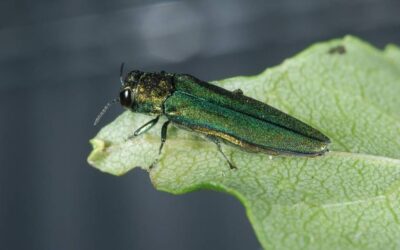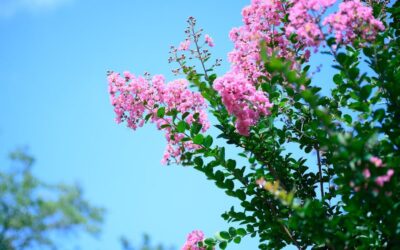Blog Topics
In this article, we describe five of the most common insect pests that attack trees in northern Virginia, plus one that we expect to see in our area soon. We cover how to identify them, when they’re active, signs of damage to look out for, and how to prevent and/or control these destructive insects.
- Aphids
- Ambrosia Beetles
- Leaf-Eating Caterpillars
- Spider Mites
- Scale Insects
- Spotted Lanternfly
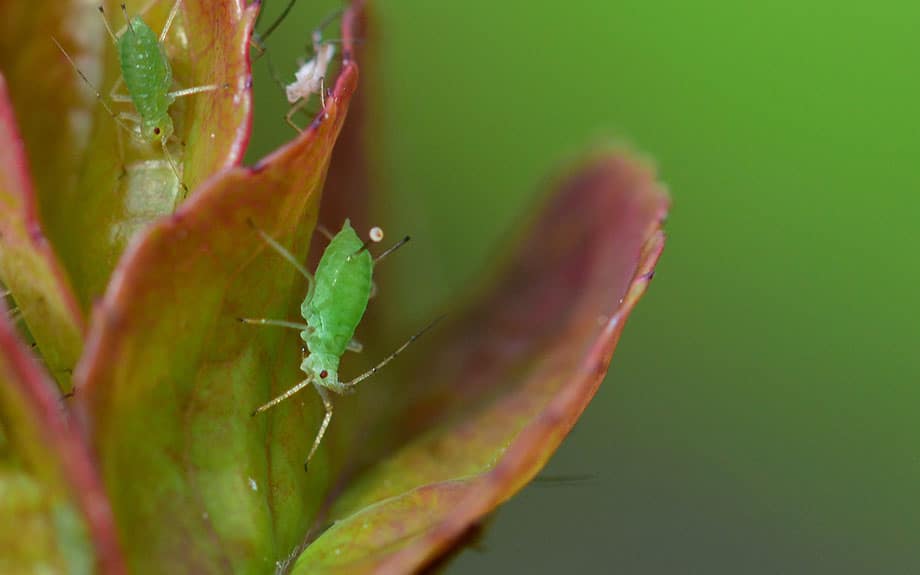
Aphids
One of the most common pests of trees and shrubs, aphids are small, soft-bodied insects that suck sap from leaves and stem.
Appearance
Most aphids are either green or black—though they may be brown, red, or yellow, or be covered with waxy filaments. They’re usually about 0.1” long (2-3 mm).
Aphids can infest almost any indoor or outdoor plant or tree. You’ll find them clustered along branches and stems, near flower buds, and on the undersides of leaves.
Timing
These pests often make their first appearance in spring. The combination of warmer temperatures, along with the emergence of tender, new green growth, creates a perfect setting for aphids. After that, they’ll likely be present in varying numbers until late fall.
Because aphids reproduce at a breathtaking rate, population numbers can explode practically overnight.
Signs of Damage
Aphids use their sharp mouthparts to pierce the surface of soft leaves and stems and suck out sap. Because aphids don’t need all the sugars they take in, they secrete the excess as a sticky substance called honeydew. This is the host of the fungus that causes sooty mold on leaves, branches, and trunks.
Besides sooty mold, aphids can also cause:
- deformed or twisted leaves and stems
- stunted growth
- yellowing leaves and stems
Treatment Options
First, keep natural aphid predators in your garden. Ladybugs and lacewings are among the most commonly found beneficial insects that eat aphids; parasitic wasps and birds also control aphids. The best way to encourage these natural controls is to keep your garden pesticide-free.
For small or delicate plants, you can try removing aphids by hand.
For stronger or larger plants, a steady stream of water from your garden hose can wash aphids off new growth. Because most aphids don’t have wings, they won’t get back on. Water will also wash off honeydew, preventing sooty mold from developing.
Heavier infestations can be treated with non-toxic soap sprays, horticultural oil sprays, and neem oil sprays.
Most plants can tolerate low levels of aphids without significant damage, so don’t worry about getting every single one.
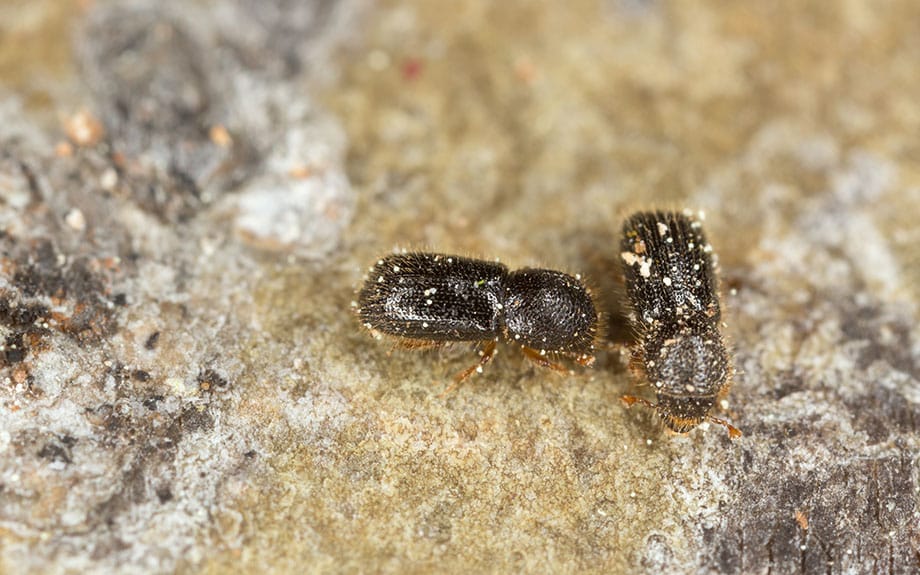
Ambrosia Beetles
Ambrosia beetles are a group of bark beetles classified in the weevil family (Curculionidae). The beetles bore or tunnel into wood to lay eggs and then add their own cultivated fungi in the tunnels for their larvae to eat. The fungi are fatal to the trees they infect.
Appearance
The beetles themselves are very small (¼” – ½”), dark brown, and not showy. The holes they bore are also small and may be hard to see.
Timing
Ambrosia beetles are active from spring through fall. Adults overwinter in leaf litter or within the wood of the host tree and emerge with spring’s warm weather.
Signs of Damage
The most common way to identify an ambrosia beetle infestation is by the piles or tubes of “frass,” or waste material, that the beetles push out of the tree. Frass tubes look a little like toothpicks sticking out of bark and frass piles look like leaking sawdust.
Ambrosia beetle damage to trees is identified by rapid crown wilting and die-back of twigs and branches. A stressed tree can die quickly during a period of hot weather, as water cannot reach the branches and leaves of its crown.
Like aphids, ambrosia beetles are non-host specific and will attack almost any tree species, native or introduced. In Virginia, ambrosia beetles have also been reported on grapevines.
Generally, ambrosia beetles attack trees that are under stress, although they’ll also attack healthy trees.
Treatment Options
Since the beetles don’t feed on their host trees, there are no systemic pesticide treatments for them.
The best treatment against ambrosia beetles is prevention by keeping your trees healthy. Ensure that trees are properly watered, have sufficient nutrients, and are properly mulched.
Trees that have been infested with ambrosia beetles should be removed to prevent them from spreading.
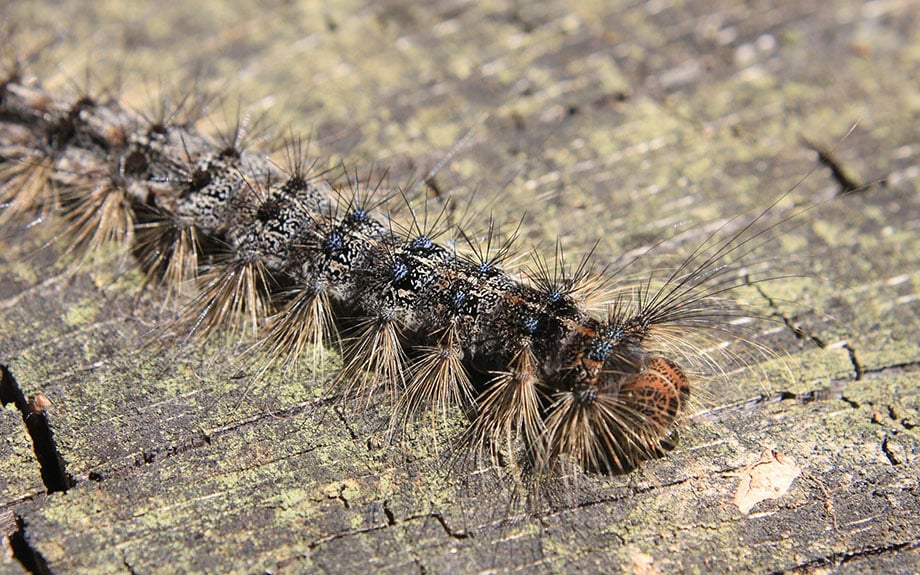
Leaf-Eating Caterpillars
Here in northern Virginia, we have three common types of caterpillar that can defoliate trees –
- Fall webworms, which create web “tents” at the end of branches
- Eastern tent caterpillars, which build tents in the forks or crotches of tree branches
- Gypsy moth caterpillars, which don’t spin webs or tents
Timing
As you’d expect, fall webworms make their appearance in mid- to late-summer and do most of their damage in fall. Eastern tent caterpillars defoliate trees in spring, as do gypsy moth caterpillars.
Signs of Damage
Aside from the webs or tents created by fall webworms and Eastern tent caterpillars, signs of damage are obvious – leaves are being eaten and the tree is becoming defoliated.
Treatment
The type and timing of treatment depends on which species is attacking your tree.
The key to controlling fall webworm and Eastern tent caterpillar is to apply an insecticidal spray to tree leaves during times when the caterpillars are actively feeding (fall or spring). Avoid spraying the webbed tents – spray won’t penetrate them so the caterpillars won’t be affected.
Gypsy moth is more difficult to control; it’s easily spread by moving items that are carrying egg masses (such as firewood). Check surfaces for egg masses and scrape off any you find. You can also wrap sticky bands around tree trunks to catch caterpillars as they climb down the tree.
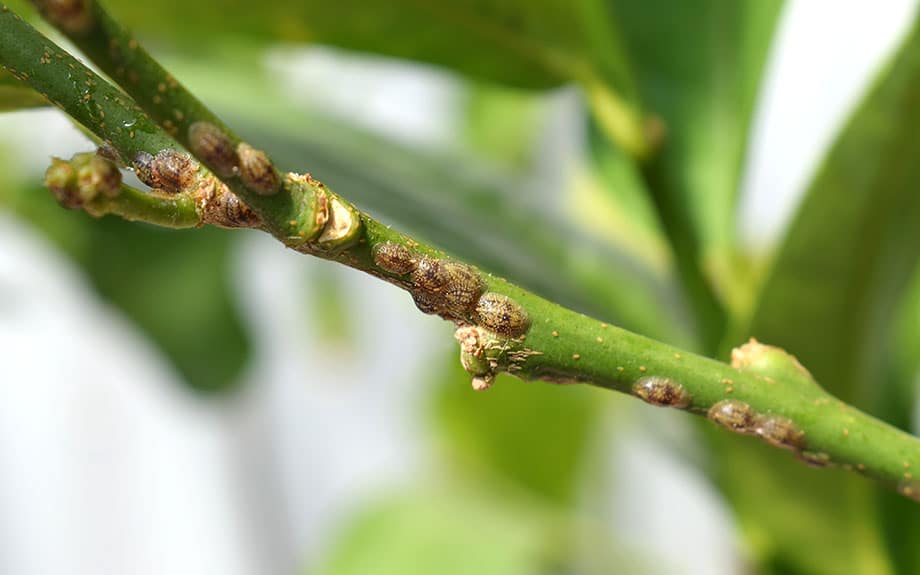
Scale
Scale insects are small insects that feed on plant sap, causing dieback and even plant death.
Appearance
Found on twigs and branches, scale insects resemble areas of overlapping fish scales.
There are over 100 species of scale insect in Virginia, classified as either soft or armored scale. The species vary in size and color, but all are small (up to 1/2″ across) and round or oval shaped. Adults are stationary, with no visible legs or antennae.
Whether soft or armored, scale insects are protected beneath their domed covering and their eggs are laid and hatched here.
In Virginia, the San Jose scale is the most destructive armored scale, while the Brown Soft Scale is one of the most wide-spread soft scales.
Timing
When they hatch in spring, immature scale insects have legs. These tiny “crawlers” set off to find a spot on the host plant where they can feed and mature into their stationary, adult form.
Signs of Damage
Similarly to aphids, scale insects pierce stems and branches to feed on plant sap, slowly reducing the plant’s energy stores and causing leaf, twig, and branch dieback. Depending on the plant, scale insect infestations can be fatal.
Treatment
Controlling scale insect is best accomplished during this brief period when the insect is unprotected. Insecticidal sprays can directly reach the immature crawling insects, while the same sprays do not penetrate the scales’ protective covering.
Effective spraying is complicated by the different life cycles of different scale insects, so a general, early-spring spraying may not work if a particular scale hatches later in the season. Horticultural oil or dormant oil sprays are useful only before trees put out leaves, fruit, or flowers. Tree care professionals are trained to identify pest species and are your best bet for scheduling effective spraying.
Remember that, like many insect pests, scale insects have natural predators. Ladybugs and lacewings are both beneficial insects you should welcome into your garden.
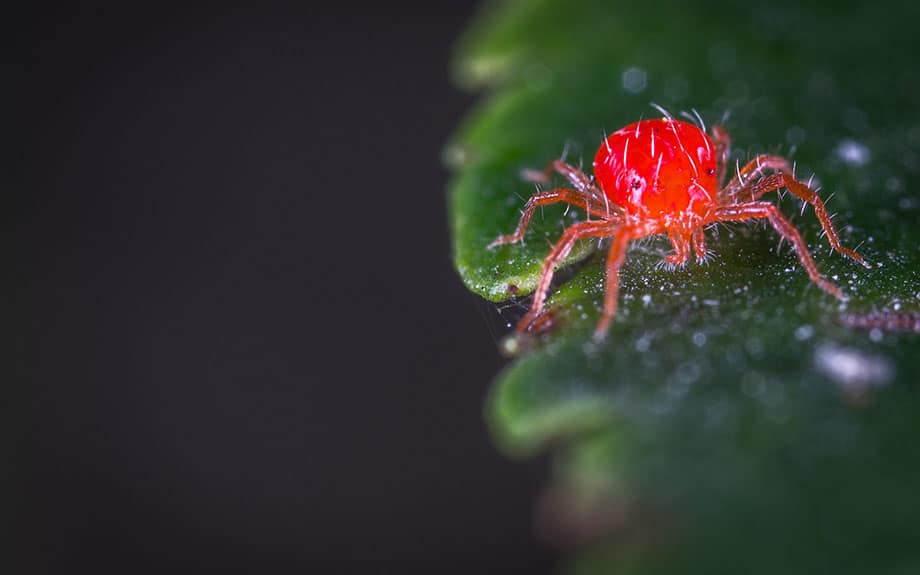
Spider Mites
Sap-sucking spider mites are not insects (they’re related to spiders and have eight legs) but they’re as destructive as other insect pests. On top of that, they’re tiny and almost impossible to see.
In northern Virginia, there are dozens of species of spider mites, and they affect too many plant species to count.
Timing
Depending on the spider mite species, adults may overwinter in soil, on the undersides of leaves, or in crevices on host trees or shrubs, or their eggs may overwinter and hatch in early spring. After hatching, spider mites mature within a month, so many generations may be created within one growing season.
Signs of Damage
To feed on plant sap, spider mites use their sharp mouthparts to rasp and scrape the surface of leaves. This results in the recognizable stippled, scarred leaf surfaces that indicate spider mite infestation.
Severely damaged leaves may look yellowed, bronzed, or bleached as plant cells die. Depending on the severity of the infestation and reduction of healthy foliage, plants may decline or die.
Spider mite populations are most likely to increase dramatically during hot, dry weather, and it’s easy to misidentify spider mite damage as plant drought stress. If you’re not certain if the damage you’re seeing is caused by heat/drought stress or spider mites, call your arborist for a professional inspection.
Treatment
Because they are so tiny, spider mites can be difficult to control. And, because they are not insects, conventional insecticides don’t work on spider mites.
If you want to spray your plants, look for horticultural miticides, neem oil, or a horticultural oil spray. Dormant oil sprays can control mite and egg populations in winter, or in early spring before growth begins,
For sturdy plants, regularly spraying a strong stream of water on leaves can wash off eggs and larvae to reduce immediate populations. Remember to wash the undersides of the leaves!
>> Learn more about spider mite identification, prevention, and control
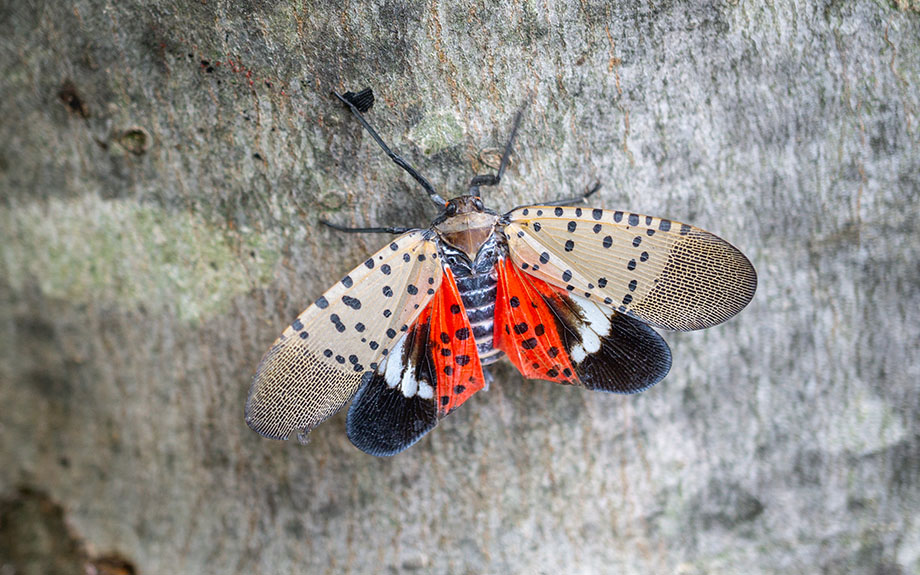
Be on the Lookout for Spotted Lanternfly
Spotted Lanternfly (SLF) is a serious and destructive pest that has recently been found in neighboring counties. SLF most likely arrived in the U.S. hidden in imported cargo and it’s spreading rapidly. Since the insect is poisonous and there are no natural predators here for this pest, controlling SLF populations is difficult.
After first appearing in Pennsylvania in 2014, SLF is now found in New Jersey and Delaware, as well as northern Virginia. Connecticut reported a single insect in 2019 and is bracing for more this year.
The Virginia Department of Agriculture and Consumer Services has created a Spotted Lanternfly Quarantine for Frederick County and the city of Winchester, northwest of Loudoun and Fairfax counties.
Spotted lanternfly feeds on more than 70 plant species, including grapes, apples, stone fruits, hops and Ailanthus altissima (Tree of Heaven), which is its preferred host. SLF poses a threat to Virginia’s peach, apple, grape and wine industries.
Visit Virginia’s Agricultural Extension for more information about spotted lanternfly in Virginia.
Residents in Loudoun and Fairfax counties are asked to keep an eye out for SLF. If you see one, immediately document and report it, and destroy any insects you find after documenting them.
If you think that you have found a spotted lanternfly, you can take a specimen to your local Virginia Cooperative Extension office. If you would rather submit a picture, please use this link. Be sure to include a street address and email where you can be reached.
Local Resources to Help With Tree Pests
The Loudon County branch of Virginia’s Cooperative Extension has resources for residents, including pesticide safety and insect identification.
You’ll find similar information on the Fairfax County’s Ag Extension website.
Virginia’s state Cooperative Extension has a pest management guide that covers home gardens.
And, of course, don’t forget that you can call the Certified Arborists at Riverbend any time! We’re available to examine your trees, identify the pest, disease, or other factors affecting your tree, and prescribe a treatment plan.
Give Us a Call at 703-402-9366
If you'd like help with your trees or landscape, have any questions, or would like to schedule an appointment with one of our Certified Arborists, please give us a call. We'd love to hear from you!

